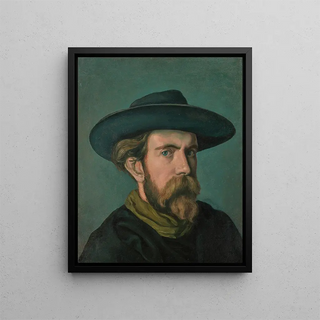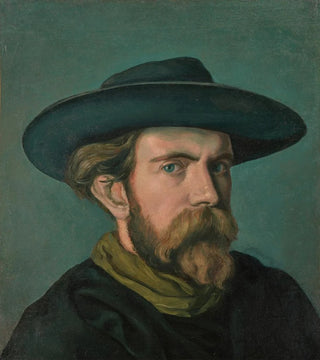Painting Self-portrait - Émile Bernard | Art print


View from behind

Frame (optional)
Autoportrait Art print - Émile Bernard – Introduction captivante
The Autoportrait Art print by Émile Bernard presents itself as an open window into the soul of an artist in search of identity and expression. This piece, created at the end of the 19th century, is much more than a simple reflection of his image. It embodies an era where artistic movements collide and where artists, like explorers, seek to redefine their place in a rapidly changing world. Through this painting, Bernard invites us to a deep introspection, skillfully blending technique and sensitivity. The intensity of his gaze, the richness of the colors, and the bold composition captivate the viewer, immersing them in a universe where art becomes a universal language.
Style and uniqueness of the work
Émile Bernard's style is characterized by a constant pursuit of harmony and light, typical of post-impressionism. In this art print, he moves away from realistic conventions to adopt a more symbolic and expressive approach. The contours are carefully outlined, while the vibrant hues, ranging from warm ochres to deep blues, create an almost mystical atmosphere. Bernard plays with shadows and lights, thus accentuating the features of his face while conveying a palpable emotion. Each brushstroke seems to tell a story, each shade of color evokes a thought or feeling. This piece is a true ode to subjectivity, where the artist reveals himself without artifice, exposing his doubts and aspirations.
The artist and his influence
Émile Bernard, an emblematic figure of the late 19th century, managed to establish himself in the art world thanks to his innovative approach and commitment to modernity. A student of Paul Gauguin, he was influenced by symbolist and Nabi movements but also developed a style that is uniquely his own. His quest for an authentic artistic language led him to explore various mediums and techniques, from painting to engraving. Bernard also played a crucial role in promoting modern art, engaging in reviews and exhibitions that helped introduce new artists. His influence is felt among many contemporary painters, and his work continues to inspire the

Matte finish

View from behind

Frame (optional)
Autoportrait Art print - Émile Bernard – Introduction captivante
The Autoportrait Art print by Émile Bernard presents itself as an open window into the soul of an artist in search of identity and expression. This piece, created at the end of the 19th century, is much more than a simple reflection of his image. It embodies an era where artistic movements collide and where artists, like explorers, seek to redefine their place in a rapidly changing world. Through this painting, Bernard invites us to a deep introspection, skillfully blending technique and sensitivity. The intensity of his gaze, the richness of the colors, and the bold composition captivate the viewer, immersing them in a universe where art becomes a universal language.
Style and uniqueness of the work
Émile Bernard's style is characterized by a constant pursuit of harmony and light, typical of post-impressionism. In this art print, he moves away from realistic conventions to adopt a more symbolic and expressive approach. The contours are carefully outlined, while the vibrant hues, ranging from warm ochres to deep blues, create an almost mystical atmosphere. Bernard plays with shadows and lights, thus accentuating the features of his face while conveying a palpable emotion. Each brushstroke seems to tell a story, each shade of color evokes a thought or feeling. This piece is a true ode to subjectivity, where the artist reveals himself without artifice, exposing his doubts and aspirations.
The artist and his influence
Émile Bernard, an emblematic figure of the late 19th century, managed to establish himself in the art world thanks to his innovative approach and commitment to modernity. A student of Paul Gauguin, he was influenced by symbolist and Nabi movements but also developed a style that is uniquely his own. His quest for an authentic artistic language led him to explore various mediums and techniques, from painting to engraving. Bernard also played a crucial role in promoting modern art, engaging in reviews and exhibitions that helped introduce new artists. His influence is felt among many contemporary painters, and his work continues to inspire the
12,34 €






